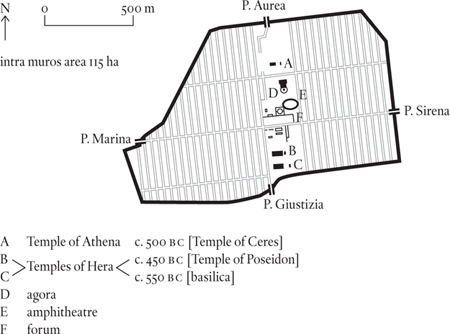
Campania, Italy
Formerly Poseidonia; in classical times, Paestum was numbered among the cities of Lucania, the province next to Campania
Poseidonia, on the Italian shin, was founded around 600 BC by Greeks from Sybaris, a colony on the instep, and one of the earliest Greek settlements in Italy. The motivation may have been to strengthen contacts between Sybaris and Etruria, the main trading partner of the Italian Greeks, and Poseidonia was well suited for this purpose, being halfway between the two. But if any such benefits accrued to the mother city they were short-lived, because Sybaris was attacked and destroyed by its neighbour, Croton, in 510 BC. Poseidonia on the other hand quickly became an exceptionally prosperous town, the period 550–450 BC seeing the construction of the three major temples (two dedicated to the city’s patron goddess Hera, and one to Athena) that have given the town its lasting fame. No one would dispute that they constitute the most impressive testimony that remains to the scale and sophistication of the Greek enterprise in peninsular Italy.
As was often the case with Greek colonies, there was no trouble initially between the colonists and the native people, who in this case were an Italic tribe, the Lucanians. They were hill folk, whereas the Greeks were only interested in the coastal plain. But in the fifth century BC a rapid increase in the native population – part of a demographic upsurge that was taking place throughout Italy – brought the Lucanians down from the mountains and on to the Poseidonian chora (rural territory). The movement was too strong for the Poseidonians to resist, and some time between 420 and 390 BC (there is no exact date in our sources) the town passed under Lucanian control. Apart from a brief ‘liberation’ by a Greek condottiere, Alexander the Molossian, in 332–326, it remained Lucanian until it was absorbed into the expanding Roman state in the early third century BC. By then the use of Greek had ceased and only one of the many Greek festivals was still being celebrated. Even the name had changed, Poseidonia being replaced by the Italic form, Paestum.
To the Romans, Paestum looked like an ideal site for a colony, and this status was duly established in 273 BC. To mark the occasion, the town was completely revamped. The original Greek plan (as evinced by the three surviving temples) had been oriented at right angles to a line connecting the north and south gates. Now, a new grid was laid out at a six-degree angle to this. (The style is still Greek, with the housing in long narrow blocks, so maybe the surveyors were brought in from NAPLES, which has a very similar layout.) At the same time, the eastern half of the city wall must have been relaid in a more rectilinear fashion, as it conforms to the new grid. In fact, the makeover was so extensive one can only assume that under Lucanian rule the town had all but died. This fits neatly with the archaeologists’ observation that whereas in the Greek period habitations in the chora are rare, in the Lucanian years they are the norm.

The resources the Romans poured into their colony of Paestum (technically Latin, at least until the imperial period) suggest that they had high hopes of it developing into a place of some importance. These hopes were never fulfilled. A second colonization – of discharged sailors from the fleet at Misenum in AD 71 – failed to remedy the situation, and after the town received a damaging coat of ash during the eruption of Vesuvius in AD 79, some of the housing seems to have been abandoned. In fact, the seismic activity around Vesuvius seems to have been the root problem, not because it erupted but because decades of subterranean movement tilted the terrain and raised the shoreline. As the shoreline lifted, the rivers around Paestum no longer flowed directly into the sea, with the result that the Paestan chora was turned into a malarial swamp. More than half a century before Vesuvius’ great eruption, the geographer Strabo had already observed that the site was waterlogged and unhealthy, and this was doubtless the reason for the town’s ultimate failure.
The last phase of Paestum’s history saw a remnant population clustered around the Temple of Athena, now a church. The bishopric of Paestum is mentioned in AD 652, but in the next century the site was abandoned in favour of Capaccio five kilometres (three miles) inland, in the relatively healthy foothills. There, a church was built to ‘Our Lady of the Pomegranate’, the goddess Hera remade in Christian guise, for the pomegranate had always been Hera’s attribute.